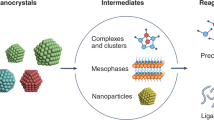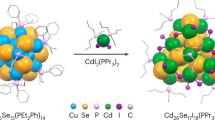Abstract
Nanocrystals prepared in organic media can be easily self-assembled into close-packed hexagonal monolayers on solvent evaporation for various applications. However, they usually rely on the use of organometallic precursors that are soluble in organic solvents. Herein we report a general protocol to transfer metal ions from an aqueous solution to an organic medium, which involves mixing the aqueous solution of metal ions with an ethanolic solution of dodecylamine (DDA), and extracting the coordinating compounds formed between the metal ions and DDA into toluene. This approach could be applied towards transferring a wide variety of transition-metal ions with an efficiency of >95%, and enables the synthesis of a variety of metallic and semiconductor nanocrystals to be carried out in an organic medium using relatively inexpensive water-soluble metal salts as starting materials. This protocol could be easily extended to synthesize a variety of heterogeneous semiconductor/noble-metal hybrids and to nanocomposites with multiple functionalities.
This is a preview of subscription content, access via your institution
Access options
Subscribe to this journal
Receive 12 print issues and online access
$259.00 per year
only $21.58 per issue
Buy this article
- Purchase on Springer Link
- Instant access to full article PDF
Prices may be subject to local taxes which are calculated during checkout






Similar content being viewed by others
Change history
13 January 2010
The originally listed authors of the above Article wish to add a further two names as co-authors. The full author list, affiliations and acknowledgements have now been corrected in the HTML and PDF versions of the Article.
References
Ferrando, R., Jellinek, J. & Johnston, R. L. Nanoalloys: From theory to applications of alloy clusters and nanoparticles. Chem. Rev. 108, 845–910 (2008).
Murray, R. W. Nanoelectrochemistry: Metal nanoparticles, nanoelectrodes, and nanopores. Chem. Rev. 108, 2688–2720 (2008).
Xia, Y., Xiong, Y., Lim, B. & Skrabalak, S. E. Shape-controlled synthesis of metal nanocrystals: Simple chemistry meets complex physics. Angew. Chem. Int. Ed. 48, 60–103 (2009).
Zhang, J., Sasaki, K., Sutter, E. & Adzic, R. R. Stabilization of platinum oxygen-reduction electrocatalysts using gold clusters. Science 315, 220–222 (2007).
Watanabe, K., Menzel, D., Nilius, N. & Freund, H.-J. Photochemistry on metal nanoparticles. Chem. Rev. 106, 4301–4320 (2006).
Bruda, C., Chen, X., Narayanan, R. & El-Sayed, M. A. Chemistry and properties of nanocrystals of different shapes. Chem. Rev. 105, 1025–1102 (2005).
Daniel, M.-C. & Astruc, D. Gold nanoparticles: Assembly, supramolecular chemistry, quantum-size-related properties, and applications toward biology, catalysis, and nanotechnology. Chem. Rev. 104, 293–346 (2004).
Brus, L. Noble metal nanoparticles: Plasmon electron transfer photochemistry and single-molecule Raman spectroscopy. Acc. Chem. Res. 41, 1742–1749 (2008).
Murray, C. B., Kagan, C. R. & Bawendi, M. G. Synthesis and characterization of monodisperse nanocrystals and close-packed nanocrystal assemblies. Annu. Rev. Mater. Sci. 30, 545–610 (2000).
Alivisatos, A. P. Semiconductor clusters, nanocrystals, and quantum dots. Science 271, 933–937 (1996).
Kuemmeth, F., Bolotin, K. I., Shi, S. & Ralph, D. C. Measurement of discrete energy-level spectra in individual chemically synthesized gold nanoparticles. Nano Lett. 8, 4506–4512 (2008).
Maheshwari, V., Kane, J. & Saraf, R. F. Self-assembly of a micrometres-long one-dimensional network of cemented Au nanoparticles. Adv. Mater. 20, 284–287 (2008).
Markovich, G., Collier, C. P. & Heath, J. R. Reversible metal–insulator transition in ordered metal nanocrystal monolayers observed by impedance spectroscopy. Phys. Rev. Lett. 80, 3807–3810 (1998).
Collier, C. P., Saykally, R. J., Shiang, J. J., Henrichs, S. E. & Heath, J. R. Reversible tuning of silver quantum dot monolayers through the metal–insulator transition. Science 277, 1978–1981 (1997).
Laurent, S. et al. Magnetic iron oxide nanoparticles: Synthesis, stabilization, vectorization, physicochemical characterizations, and biological applications. Chem. Rev. 108, 2064–2110 (2008).
Jeong, U., Teng, X., Wang, Y., Yang, H. & Xia, Y. Superparamagnetic colloids: Controlled synthesis and niche applications. Adv. Mater. 19, 33–60 (2007).
Sun, S. Recent advances in chemical synthesis, self-assembly, and applications of FePt nanoparticles. Adv. Mater. 18, 393–403 (2006).
Caswell, K. K., Bender, C. M. & Murphy, C. J. Seedless, surfactantless wet chemical synthesis of silver nanowires. Nano Lett. 3, 667–669 (2003).
Kim, F., Song, J. H. & Yang, P. Photochemical synthesis of gold nanorods. J. Am. Chem. Soc. 124, 14316–14317 (2002).
Sun, Y. & Xia, Y. Shape-controlled synthesis of gold and silver nanoparticles. Science 298, 2176–2179 (2002).
Shankar, S. S. et al. Biological synthesis of triangular gold nanoprisms. Nature Mater. 3, 482–488 (2004).
Jin, R. et al. Photoinduced conversion of silver nanospheres to nanoprisms. Science 294, 1901–1903 (2001).
Dahl, J. A., Maddux, B. L. S. & Hutchison, J. E. Toward greener nanosynthesis. Chem. Rev. 107, 2228–2269 (2007).
Wang, X., Zhuang, J., Peng, Q. & Li, Y. A general strategy for nanocrystal synthesis. Nature 437, 121–124 (2005).
Cushing, B., Kolesnichenko, V. L. & O’Connor, C. J. Recent advances in the liquid-phase synthesis of inorganic nanoparticles. Chem. Rev. 104, 3893–3946 (2004).
Brust, M., Walker, M., Bethell, D., Schiffrin, D. J. & Whyman, R. Synthesis of thiol-derivatized gold nanoparticles in a two-phase liquid–liquid system. J. Chem. Soc. Chem. Commun. 7, 801–802 (1994).
Roundhill, D. M. (ed.) Extraction of Metals from Soils and Waters (Kluwer–Academic/Plenum, 2001).
McClune, W. F. (ed.) Powder Diffraction File Alphabetical Index Inorganic Phase (JCPDS, 1980).
Link, S., Wang, Z. L. & El-Sayed, M. A. Alloy formation of gold-silver nanoparticles and the dependence of plasmon absorption on their composition. J. Phys. Chem. B 103, 3529–3533 (1999).
Wagner, C. D. et al. NIST Standard Reference Database 20, version 3.2 (web version).
Sun, Y., Mayers, B. & Xia, Y. Template-engaged replacement reaction: A one-step approach to the large-scale synthesis of metal nanostructures with hollow interiors. Nano Lett. 2, 481–485 (2002).
Sun, Y. & Xia, Y. Multiple-walled nanotubes made of metals. Adv. Mater. 16, 264–268 (2004).
Sun, Y. & Xia, Y. Mechanistic study on the replacement reaction between silver nanostructures and chloroauric acid in aqueous medium. J. Am. Chem. Soc. 126, 3892–3901 (2004).
Yang, J., Lee, J. Y., Too, H. P. & Valiyaveettil, S. A bis(p-sulfonatophenyl)phenylphosphine-based synthesis of hollow Pt nanospheres. J. Phys. Chem. B 110, 125–129 (2006).
Tan, Y.-N., Yang, J., Lee, J. Y. & Wang, D. I. C. Mechanistic study on the bis(p-sulfonatophenyl)phenylphosphine synthesis of monometallic Pt hollow nanoboxes using Ag*–Pt core–shell nanocubes as sacrificial templates. J. Phys. Chem. C 111, 14084–14090 (2007).
Zhang, Q., Lee, J. Y., Yang, J., Boothroyd, C. & Zhang, J. Size and composition tunable Ag–Au alloy nanoparticles by replacement reactions. Nanotechnology 18, 245605 (2007).
Aldana, J., Wang, A. & Peng, X. Photochemical instability of CdSe nanocrystals coated by hydrophilic thiols. J. Am. Chem. Soc. 123, 8844–8850 (2001).
Mokari, T., Rothenberg, E., Popov, I., Costi, R. & Banin, U. Selective growth of metal tips onto semiconductor quantum rods and tetrapods. Science 304, 1787–1790 (2004).
Pacholski, C., Kornowski, A. & Weller, H. Nanomaterials: Site-specific photodeposition of silver on ZnO nanorods. Angew. Chem. Int. Ed. 43, 4774–4777 (2004).
Milliron, D. J. et al. Colloidal nanocrystal heterostructures with linear and branched topology. Nature 430, 190–195 (2004).
Gu, H., Zheng, R., Zhang, X. & Xu, B. Facile one-pot synthesis of bifunctional heterodimers of nanoparticles: A conjugate of quantum dot and magnetic nanoparticles. J. Am. Chem. Soc. 126, 5664–5665 (2004).
Yu, H. et al. Dumbbell-like bifunctional Au–Fe3O4 nanoparticles. Nano Lett. 5, 379–382 (2005).
Li, Y., Zhang, Q., Nurmikko, A. V. & Sun, S. Enhanced magnetooptical response in dumbbell-like Ag–CoFe2O4 nanoparticle pairs. Nano Lett. 5, 1689–1692 (2005).
Yi, D. K. et al. Silica-coated nanocomposites of magnetic nanoparticles and quantum dots. J. Am. Chem. Soc. 127, 4990–4991 (2005).
Shi, W. et al. A general approach to binary and ternary hybrid nanocrystals. Nano Lett. 6, 875–881 (2006).
Selvan, S. T., Patra, P. K., Ang, C. Y. & Ying, J. Y. Synthesis of silica-coated semiconductor and magnetic quantum dots and their use in the imaging of live cells. Angew. Chem. Int. Ed. 46, 2448–2452 (2007).
Jiang, J. et al. Bifunctional Fe3O4–Ag heterodimer nanoparticles for two-photon fluorescence imaging and magnetic manipulation. Adv. Mater. 20, 4403–4407 (2008).
Mokari, T., Sztrum, C. G., Salant, A., Rabani, E. & Banin, U. Formation of asymmetric one-sided metal-tipped semiconductor nanocrystal dots and rods. Nature Mater. 4, 855–863 (2005).
Son, D. H., Hughes, S. M., Yin, Y. & Alivisatos, A. P. Cation exchange reactions in ionic nanocrystals. Science 306, 1009–1012 (2004).
Park, J. et al. Ultra-large-scale syntheses of monodisperse nanocrystals. Nature Mater. 3, 891–895 (2004).
Acknowledgements
We thank Y. K. Kuan of the Institute of Bioengineering and Nanotechnology, Singapore, for his assistance in characterizing the Pt hollow nanospheres. J.Y. and J.Y.Y. acknowledge the support by the Institute of Bioengineering and Nanotechnology (Biomedical Research Council, Agency for Science, Technology and Research, Singapore). J.Y., E.H.S. and S.O.K. acknowledge the University of Toronto, the US Air Force (MURI grant to S.O.K.) and the NIH (CA1222878-01A2). E.H.S. also acknowledges the Canada Research Chairs, the Canada Foundation for Innovation, and the Natural Sciences and Engineering Council of Canada.
Author information
Authors and Affiliations
Corresponding authors
Supplementary information
Rights and permissions
About this article
Cite this article
Yang, J., Sargent, E., Kelley, S. et al. A general phase-transfer protocol for metal ions and its application in nanocrystal synthesis. Nature Mater 8, 683–689 (2009). https://doi.org/10.1038/nmat2490
Received:
Accepted:
Published:
Issue Date:
DOI: https://doi.org/10.1038/nmat2490
This article is cited by
-
Adsorption behavior of lead, cadmium, and arsenic on manganese-modified biochar: competition and promotion
Environmental Geochemistry and Health (2024)
-
Epitaxial growth of highly symmetrical branched noble metal-semiconductor heterostructures with efficient plasmon-induced hot-electron transfer
Nature Communications (2023)
-
Reversible phase-transfer mediated single reverse micelle towards synthesis of silver nanocrystals
Science China Technological Sciences (2020)
-
Ion exchange: an advanced synthetic method for complex nanoparticles
Nano Convergence (2019)
-
Facile Hydrophobication of Glutathione-Protected Gold Nanoclusters and Encapsulation into Poly(lactide-co-glycolide) Nanocarriers
Scientific Reports (2019)



